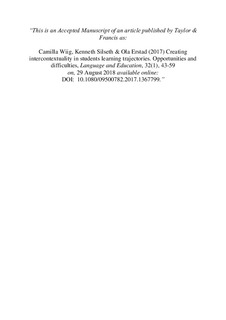| dc.contributor.author | Wiig, Astrid Camilla | |
| dc.contributor.author | Silseth, Kenneth | |
| dc.contributor.author | Erstad, Ola | |
| dc.date.accessioned | 2019-03-13T09:42:41Z | |
| dc.date.available | 2019-03-13T09:42:41Z | |
| dc.date.created | 2017-12-19T08:52:19Z | |
| dc.date.issued | 2018 | |
| dc.identifier.citation | Language and Education. 2018, 32 (1), 43-59. | nb_NO |
| dc.identifier.issn | 0950-0782 | |
| dc.identifier.uri | http://hdl.handle.net/11250/2589815 | |
| dc.description.abstract | This article explores how opportunities and limitations in creating intercontextualtiy between everyday and scientific ideas emerge in teacher–student interactions, with a particular focus on the teacher’s role. The article draws on data from an empirical, longitudinal, study in a lower secondary school in Norway to analyze student-teacher interactions in regular lessons. The analysis is based on sociocultural and dialogical approaches to meaningmaking and learning, in which video data is subjected to interaction analysis. Our main findings illustrate that creating intercontextuality in students’ learning trajectories, by building on everyday knowledge and experiences as resources for classroom interactions, remains a complex task. In the classrooms we have followed, the findings show that the teacher’s narratives of how to frame learning activities and position the students in meaning-making process are grounded in teachers’ norms and assumptions of what constitutes appropriate resources to engage students’ in the dialogic creation of intercontextuality. These findings have implications for how teachers frame learning activities where students get opportunities to build upon relevant resources for discussing ideas brought to life in complex social interactions. | nb_NO |
| dc.description.abstract | Creating intercontextuality in students learning trajectories: Opportunities and difficulties | nb_NO |
| dc.language.iso | eng | nb_NO |
| dc.title | Creating intercontextuality in students learning trajectories: Opportunities and difficulties | nb_NO |
| dc.type | Journal article | nb_NO |
| dc.type | Peer reviewed | nb_NO |
| dc.description.version | acceptedVersion | nb_NO |
| dc.source.pagenumber | 43-59 | nb_NO |
| dc.source.volume | 32 | nb_NO |
| dc.source.journal | Language and Education | nb_NO |
| dc.source.issue | 1 | nb_NO |
| dc.identifier.doi | 10.1080/09500782.2017.1367799 | |
| dc.identifier.cristin | 1529355 | |
| dc.relation.project | Norges forskningsråd: 530641 | nb_NO |
| cristin.unitcode | 222,59,7,0 | |
| cristin.unitname | Institutt for pedagogikk | |
| cristin.ispublished | true | |
| cristin.fulltext | original | |
| cristin.fulltext | postprint | |
| cristin.qualitycode | 1 | |
